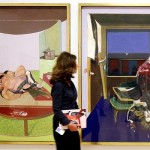
Abstract
The semiotic approach that is attempted in this paper concerns the phenomenon of reflectivity that is caused by the imposition of glass panes in front of the paintings of Francis Bacon (1909-1992) during their exhibition. First, I investigate the properties of glass that sustain a conceptualization of its functions within the space of an art exhibition, pointing out its character as a semiotic boundary. Then, I examine the implications of views of the glass panes as technical or artistic devices, moving forward to their inclusion into the researcher’s conception of the artistic text, and further analyzing this textualization with regard specifically to reflectivity, using the theory of Juri Lotman on the structure of the artistic text. Finally, I attempt to integrate some considerations on Bacon’s aesthetics, in order to illustrate the significance of reflectivity within the specific context of his artistic endeavor.
Keywords glass, reflectivity, boundary, textualization, juxtaposition
Introduction
The purpose of this paper is to provide a semiotic approach to the phenomenon of reflectivity that accompanies the shielding of the paintings of British painter Francis Bacon (1909-1992) with glass panes, during their exhibition in art galleries and art museums (see Fig. 1, 2, 3). For this purpose, I will examine the potential implications of excluding or incorporating the glass panes from or into the artistic text of the painting respectively, focusing on the latter of these options and extending its consequences on the theoretical level, as far as reflectivity is concerned. The textualization, whose dynamics I investigate, is guided basically by the theory of Juri Lotman on the structure of the artistic text, but I will furthermore attempt to integrate a conceptual analysis of the spatial-functional dimension of this phenomenon and further elementary considerations that pertain to the aesthetics of Bacon’s art, which might contribute to the illumination of the significance of reflectivity in his art.
Spatial-functional conceptualization: the glass pane as semiotic boundary
Let me examine first what are the relevant properties of the glass as material that justify its installment in front of a work of art. The most obvious one, and the sine qua non for its use, is its transparency: it enables the viewer to see what is behind it. The most effective one, and its functional legitimization, is its insulative capacity: it protects what is behind it from being directly, physically touched or otherwise accessed and harmed; this quality of the glass, when it comes to its usage within the context of an art exhibition space, serves the usual “conservation considerations, or protection against the most insane threats from the public” (Poprzęcka, 2010: para. 1). The third, perhaps distracting, property of the glass is its reflectivity: “Glass is transparent. But when placed on a non-transparent surface, it becomes reflective. The painting […] works as the amalgam, so that the glass that is ‘coated’ with it becomes a mirror” (ibid: para. 2). The glass though is not a mirror, but has only one mirroring function along with the other two mentioned before.
